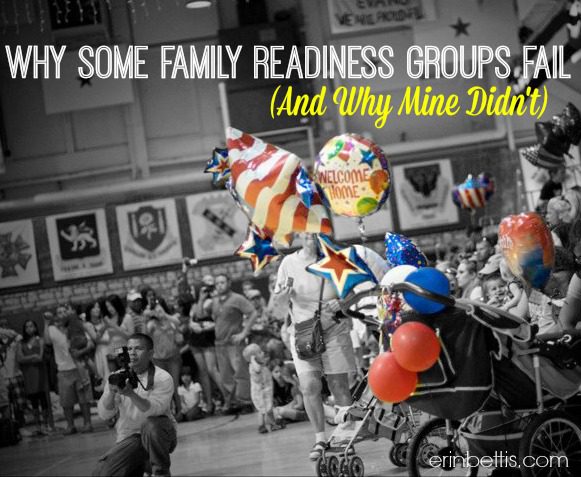
Redefining FRG Leadership: From Reluctant Attendee to Award-Winning Leader
A show of hands: How many military spouses out there wince at hearing ‘Family Readiness Group’? At one time, mine was probably the highest-raised hand in the room. Like many, I became squeamish at the thought of having to attend a meeting, and I never participated in a fundraiser. I avoided anyone and anything having to do with the organization, but that mentality, and ultimately my participation, drastically changed. I eventually became a Family Readiness Group Leader.
Not only did I build the group from the ground up, but our volunteers consistently won installation-wide awards and recognition for excellence. How did I go from zero involvement, to starting the FRG myself, to having an all-star team and the best FRG in the unit? In short: My perpetual drive to help others.
In a nutshell, the Family Readiness Group, or FRG, is an organization open to service members, spouses, fiances, girlfriends, boyfriends, extended family members, civilian employees, and local community members. In other words, whoever wants to be a part of the FRG, can. It is also an official organization in some, but not all, United States Uniformed Services branches. Anyone can start an FRG, but it is typically the responsibility of the Commanding Officer. Also, it’s customarily the FRG’s objective to support the Commander’s mission to help the families of service members by promoting self-sufficiency, resiliency, and stability in times of peace and war. There is an FRG Leader who runs monthly meetings and oversees other volunteers, which usually includes Key Callers, a treasurer, a secretary, and other volunteers as needed (we also had a newsletter writer and welcome committee.)
Before getting involved, I always thought of the FRG as your typical dull high school club, and these are the reasons why I avoided the FRG like a trip to the DMV:
- There’s often an overconfident leader who intimidates newcomers.
- They’re boring meetings that suck the life out of the room.
- There’re fundraisers to raise money for who-knows-what, which often feel like forced fun.
- The clique-y drama.
When I first joined the company, there was no appointed FRG Leader. When the situation became clear that no one else was stepping into the role as FRG Leader in this company, I felt a considerable hole inside me. For months I wondered what would happen to the soldiers’ spouses and extended family members. It kept me awake at night, these thoughts. No other woman was willing to come into the light to help out her fellow wives. I knew it was a significant role, but was there someone out there who cared as much as me to go on and lead the thing?
No one wanted the role.
Thinking about the current stigma of many FRGs nationwide made me sad. I was sad that the FRG’s negative reputation keeps other women from having access to the support they – and I – desperately needed.
After months of uncertainty, I finally put my toes into the light. Before long, I was fully engulfed in the position of FRG Leader. I decided to drop other extracurricular activities to give our group the full attention it needed. This was difficult at first, but knowing the importance I was placing on this role, and knowing it wasn’t forever, was a sacrifice I was willing to make for the sake of all the other families I wanted to help.
When I began, I had only one goal: That every spouse knew she was not alone. She needed to know that someone was there to befriend, guide, and listen to her. She needed to know that there was someone to stand beside her and encourage her. I gave the company an FRG I would want to participate in. One without the overconfident leader. One without monthly meetings about nothing topics. One without absurd drama. Our FRG was relaxed yet inviting, thoughtful, and resourceful. And soon after that, I suddenly saw other people stepping into the light to stand beside me. I had these fabulously brave spouses offer to help whenever I needed. All I did was create an environment full of love and support, one in which I would want to participate as a member, and others soon discovered that they, too, wanted in.
Within a short while, I had 7 other volunteers working seamlessly together toward our goal of reaching every single spouse.
We spent seemingly endless hours on the phone, in email, and text, talking to, listening to, and offering our help to our spouses. We didn’t have nothing-topic meetings. Instead, we only had two meetings that year. The first was to formally introduce myself. The other was a massive attack to end domestic violence in the company. We arranged free childcare and welcomed two guest speakers to help give our spouses the courage to stand up for themselves and learn not to accept an unhealthy relationship. Without our FRG in place, there would have been no way for command, let alone other spouses, to unravel the alleged abuse. Many spouses wouldn’t have had the courage to seek the needed resources without our FRG. You could feel the strength in our numbers.
The environment our team created was recognized by the unit commanding officer and formally by the official installation volunteer organizer. Together, we clocked in over 1,000 volunteer hours to aid in the support of our sister spouses.
I had no idea how to lead an FRG when I began, but I knew what wasn’t working in other FRGs, and therefore strategized my leadership to create a network that succeeded. In fact, we flourished.
